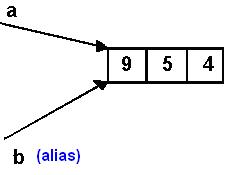
An array is an aggregate data structure that is designed to store a group of objects of the same or different types. Arrays can hold primitives as well as references. The array is the most efficient data structure for storing and accessing a sequence of objects.
Here is the list of most important array features you must know (i.e. be able to program)
You already know that the Java language has only two data types, primitives and references. Which one is an array? Is it primitive? An array is not a primitive data type - it has a field (and only one), called length. Formally speaking, an array is a reference type, though you cannot find such a class in the Java APIs. Therefore, you deal with arrays as you deal with references. One of the major diffeences between refeences and primituives is that you cannot copy arrays by assigning one to another:
int[] a = {9, 5, 4};
int[] b = a;
The assignment operator creates an alias to the object, like in the picture below

Since these two references a and b refer to the same object, comparing them with the double equal sign "==" will always return true. In the next code example,
int [] a = {1,2,3};
int [] b = {1,2,3};
equals method. For array
comparison, the Java APIs provides the Arrays class.
The java.util.Arrays class is a convenience class for
various array manipulations, like comparison, searching, printing, sorting and others.
Basically, this class is a set of static methods that are all useful for working with arrays.
The code below demonstrates a proper invocation of equals:
int[] a = {1,2,3};
int[] b = {1,2,3};
if( Arrays.equals(a, b) )
System.out.println("arrays with identical contents");
Another commonly used method is toString() which takes care of of printing
int[] a = {1,2,3};
System.out.println(Arrays.toString(a));
Here is the example of sorting
int[] a = {2,1,3};
Arrays.sort(a);
System.out.println(Arrays.toString(a));
Once an array is sorted we use the binary search algorithm for efficient searching
int[] a = {2,1,3};
Arrays.sort(a);
System.out.println(Arrays.binarySearch(a,2));
In addition to that, the class has other utility methods for supporting operations over multidimensional arrays.
There are four ways to copy arrays
Arrays.copyOf()
System.arraycopy()
clone()
The first way is very well known to you
int[] a = {1, 2, 3};
int[] b = new int[a.length];
for(int i = 0; i ‹ a.length; i++) b[i] = a[i];
The next choice is to use Arrays.copyOf()
int[] a = {1, 2, 3};
int[] b = Arrays.copyOf(a, a.length);
The second parameter specifies the length of the new array, which could either less or equal or bigger than the original length.
The most efficient copying data between arrays is provided by
System.arraycopy() method. The method requires five arguments. Here is its signature
public static void arraycopy(Object source,
int srcIndex,
Object destination,
int destIndex,
int length)
The method copies length elements from a source array
starting with the index srcIndex to a new array
destination at the index destIndex.The above code
example can be rewritten as it follows
int[] a = {1, 2, 3};
int[] b = new int[a.length];
System.arraycopy(a, 0, b, 0, 3)
And the last copying choice is the use of cloning. Cloning involves
creating a new array of the same size and type and copying all the old
elements into the new array. The clone() method is defined in the
Object class and its invocation is demonstrated by this code segment
int[] a = {1, 2, 3};
int[] b = (int[]) a.clone();
Note, that casting (int[]) is the must.
Examine the code in ArrayCopyPrimitives.java for further details.
Arrays in Java have no methods and only one immutable field length.
Once an array is created, its length is fixed and cannot be changed. What do you do to
resize the array? You allocate the array with a different size and copy the contents of
the old array to the new array. This code example demonstrates deletion from an array of primitives
public char[] delete(char[] data, int pos)
{
if(pos >= 0 && pos < data.length)
{
char[] tmp = new char[data.length-1];
System.arraycopy(data, 0, tmp, 0, pos);
System.arraycopy(data, pos+1, tmp, pos, data.length-pos-1);
return tmp;
}
else
return data;
}
The first arraycopy copies the elements from index 0 to index pos-1, the second arraycopy copies the elements from index pos+1 to data.length.
Examine the code in ArrayDemo.java for further details.
Since the array size is fixed, an array can only hold a certain number of items. In many practical cases, it would be really helpful if we could increase (or descrease) the size of an array on demand.
The java.util.ArrayList class supports an idea of a dynamic array - an array that grows and shrinks on demand to accomodate the number of elements in the array. Below is a list of commonly used methods
The following code example will give you a heads up into how some of them are used.
/* ADD */
ArrayList<Integer> num = new ArrayList<Integer>();
for(int i = 0; i < 10; i++) num.add(i);
System.out.println(num);
/* REMOVE even integers */
for(int i = 0; i < num.size(); i++)
if(num.get(i)%2 == 0) num.remove(i);
System.out.println(num);
The ArrayList implements the doubling-up policy when an array does not have enough capacity for insertion:
public void add(int index, Object x)
{
if(index >= 0)
{
ensureCapacity(size + 1);
System.arraycopy(items, index, items, index + 1, size - index);
items[index] = x;
size++;
}
}
private void ensureCapacity( int newCapacity )
{
if( newCapacity >= size )
{
Object[] tmp = new Object[2 * items.length];
System.arraycopy(items, 0, tmp, 0, size);
items = tmp;
}
}
However, the deletion resizing policy in Java is not that efficient. The ArrayList resizes an internal array each time the method remove() is called. Examine the code in ArrayListDemo.java for time comparison between add() and remove() implementations..
Algorithm (1946): - locate the element x in a sorted array by first comparing x with the middle element and then (if they are not equal) dividing the array into two subarrays; if x is less than the middle element you repeat the whole procedure in the left subarray, otherwise - in the right subarray. The procedure repeats until x is found or subarray is a zero dimension. We assume that the array is sorted in ascending order.
Design (Pseudocode)
if (size ≤ 0)
return -1;
else
{
middle = // find the midpoint;
if( x == a[middle] ) // x is a target
return x
else if (x < a[middle])
search in the area before the midpoint;
else
search in the area after the midpoint;
}
Example.
{-23, -2, 5, 8, 23, 44, 78, 99, 101}
The algorithm is implemented by maintaining three indexes:
right = array.length-1; // 8 left = 0; // 0 mid = (right+left)/2; // 4
right = mid-1; // 3
// 0 left is unchanged
mid = (right+left)/2; // 1
// 3 right is unchanged
left = mid+1; // 2
mid = (right+left)/2; // 2
// 3 right is unchanged
left = mid+1; // 3
mid = (right+left)/2; // 3
This topic is more complex for understanding.. Let us start with a simple loop structure
Object[] obj1 = {new Integer(10),
new StringBuffer("foobar"),
new Double(12.95)};
Object[] obj2 = new Object[obj1.length];
for(int i = 0; i ‹ obj1.length; i++)
obj2[i] = obj1[i];
At the first glance we might think that all data is copied. In reality, the internal data is shared between two arrays. The figure below illustrates the inner structure
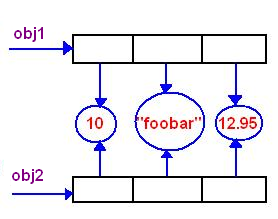
The assignment operator obj2[i] = obj1[i] is a crucial part of
understanding the concept. You cannot copy references by assigning one
to another. The assignment creates an alias rather than a copy. Let us trace down
changes in the above picture after execution the
following statements
obj1[0] = new Integer(5);
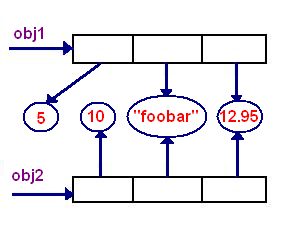
and ((StringBuffer) obj1[1]).append('s');
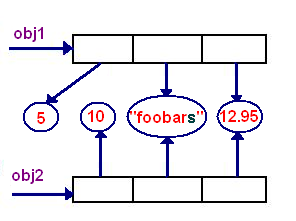
As you see, obj1[0] and obj2[0] now refer to different objects. However, obj1[1] and obj2[1] refer to the same object (which is "foobars"). Since both arrays shares the data, you must be quite careful when you modify your data, because it might lead to unexpected effects.
The same behavior will take place again, if we use Arrays.copuyOf(),
System.arraycopy()
and clone(). Examine the code example ArrayCopyReferences.java for further details.
In many practical application there is a need to use two- or multi-dimensional arrays. A two-dimensional array can be thought of as a table of rows and columns. This creates a table of 2 rows and 4 columns:
int[][] ar1 = new int[2][4];
You can create and initialize an array by using nested curcly braces. For example, this creates a table of 3 rows and 2 columns:
int[][] ar2 = {{1,2},{3,4},{5,6}};
Generally speaking, a two-dimensional array is not exactly a table - each row in such array can have a different length. Consider this code fragment
Object[][] obj = {{new Integer(1),new Integer(2)},
{new Integer(10), "bozo", new Double(1.95)}};
The accompanying picture sheds a bit of light on internal representation
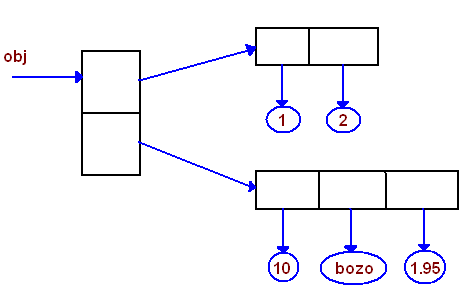
From the picture you clearly see that a two-dimensional array in Java is
an array of arrays. The array obj has two elements obj[0]
and obj[1] that are arrays of length 2 and 3 respectively.
The procedure is even more confusing and less expected. Consider the following code segment
Object[][] obj = {{new Integer(1),new Integer(2)},
{new Integer(10), "bozo", new Double(1.95)}};
Object[][] twin = (Object[][]) obj.clone();
The procedure of clonig 2d arrays is virtually the same as cloning an array of references. Unfortunately, built-in clone() method does not actualy clone each row, but rather creates references to them Here is a graphical interpretation of the above code
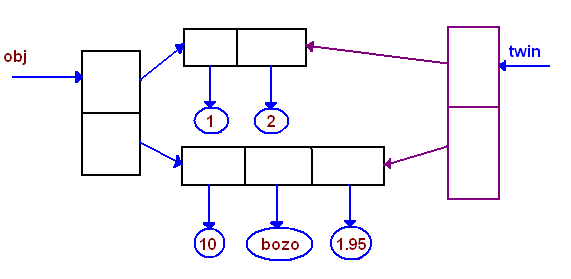
Let us change the value of obj[1][1]
obj[1][1] = "xyz";
This assignment effects the value of twin[1][1] as well
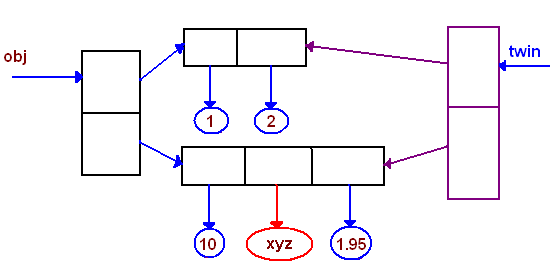
Such a copy is called a "shallow" copy. The default behavior of clone() is to return a shallow copy of the object. If we want a "deep" copy instead, we must provide our own implementation by overriding Object's clone() method.
The idea of a "deep" copy is simple - it makes a distinct copy of each of the object's fields, recursing through the entire object. A deep copy is thus a completely separate object from the original; changes to it don't affect the original, and vise versa. In relevance to the above code, here is a deep clone graphically
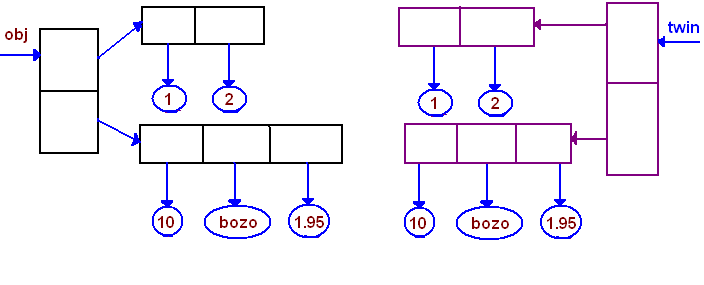
Further, making a complete deep copy is not always needed. Consider an array of immutable objects. As we know, immutable objects cannot be modified, allowing clients to share the same instance without interfering with each other. In this case there is no need to clone them, which leads to the following picture
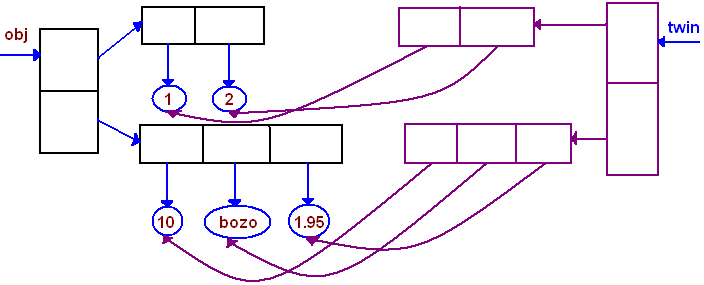
Always in this course we will create data structures of immutable objets, therefore implementing the clone method will require copying a structure (a shape) and sharing its internal data. We will discuss these issues later on in the course.